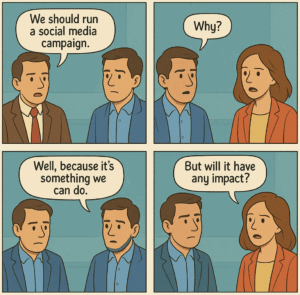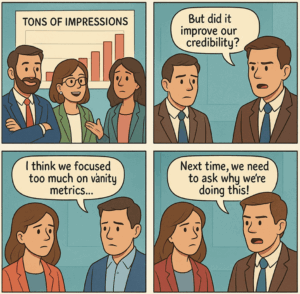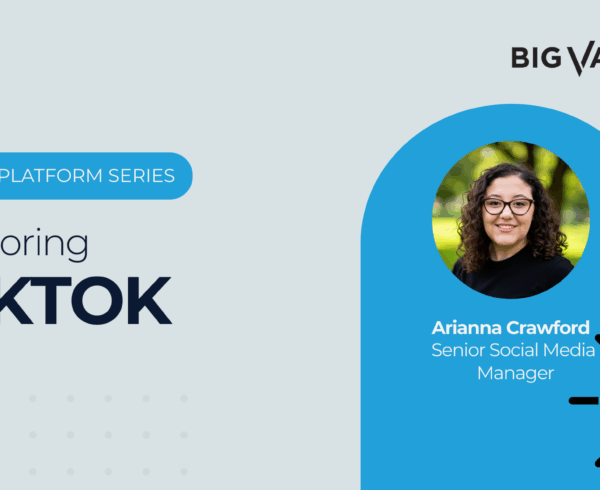Curiosity is not a weakness. It’s how we win.
Every leader faces the same temptation: to accept the first answer, the first number, the first chart that looks convincing. Why resists that temptation. It refuses the easy surface, keeping curiosity alive and forcing clarity, especially when assumptions feel more convenient than evidence.
Asking “why” again and again models the oldest method of learning we have — the Socratic method. It’s a discipline. One that turns instinct into intelligence and data into something you can actually use. In research and measurement, that discipline turns instinct into intelligence. Each question peels away assumptions and forces sharper thinking.
Why Before What
We’ve all experienced it: the campaign request that starts with a volume target. More coverage. More impressions. More buzz. But why that coverage? Why this audience? Why now? Why does trust even matter in this context?
Without those questions, research design stays fuzzy, tactics become detached, and measurement risks turning into theater — full of activity, light on impact. Teams won’t be as successful if they don’t know the reasons why they are doing something.
Why reframes the whole process. It sharpens objectives, aligns methods, and produces insights that actually mean something. Purpose makes strategy click: it turns guesswork into alignment and data into direction. Why is how marketing and communications stops floating and starts connecting — to audiences, to business goals, to change that matters.
Why Reveals What Really Matters
“Why” isn’t just a question — it’s a filter. It cuts through assumptions and gets you to the truth. A spike in media coverage? More impressions? A dip in engagement? Without asking why, it’s easy to default to the nearest explanation — clicks mean awareness, mentions mean credibility, fewer likes mean people don’t care. But those are guesses, not insights.
At the first level, “why” sharpens communication strategy itself: Why this audience? Why this message? Why now? It forces clarity before tactics hit the timeline. But the real power of “why” is what happens when you zoom out.
It uncovers the actual goal behind the request. “More coverage” might sound like a volume play, but it’s often code for something deeper: building trust with skeptics, increasing credibility in a crowded market, or changing how key decision-makers perceive your brand. Without “why,” teams chase tactics. With it, they pursue change.
That shift matters — not just for measurement, but for credibility, budgets, and business alignment.

Image created via ChatGPT based on guidance from the authors.
Why Outs Fake Metrics
Not all numbers are equal.
Impressions. Clip counts. Share of voice. They sound great in a report. But what do they actually tell you? More coverage does not mean more credibility. More mentions do not guarantee more trust.
Why is the flashlight in the dark corner of the dashboard. It asks:
- How did awareness shift?
- How did perceptions change?
- What impact did it have on key audiences…on the business?
When you apply “why,” vanity metrics start looking less shiny. And that’s a good thing — because real impact doesn’t hide in volume. It hides in meaning.
Why Builds Stronger Leaders
The best leaders don’t just present numbers — they press until the numbers explain impact. Not just what changed, but why it mattered. They don’t stop at “our media volume increased.” They ask: Did we reach the right audience? Did we shift perception? Did we move the needle on trust, behavior, or business goals?
That kind of clarity changes the conversation. It earns trust — with clients, with boards, with teams. “Why” turns data into decisions and activity into authority. It’s how leaders become not just confident, but convincing.

Image created via ChatGPT based on guidance from the authors.
Why Isn’t Doubt — It’s Discipline
Why is not about doubt. It is about discipline. Ask it until assumption gives way to understanding, vanity gives way to outcomes, and activity gives way to impact. Asking doesn’t mean you don’t trust the data. It means you care enough to understand it. To go beyond dashboards and dig into decisions. To push past the illusion of progress and find the real impact.
So ask the hard questions:
- How do I challenge the story behind my strongest number?
- How do I show change, not just activity?
- How do I connect this to what really matters?
Because when you practice the discipline of why, assumptions crumble. Outcomes sharpen. And measurement does what it’s meant to do: show value, not just presence.











